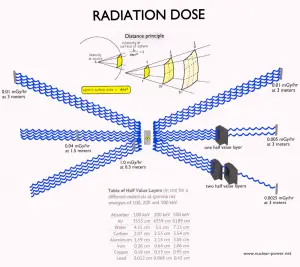 Radiation dose is a measure of the amount of exposure to ionizing radiation. It is known, that ionizing radiation can penetrate the human body or an object. The energy absorbed from this exposure to radiation is called a radiation dose or simply a dose: absorbed, equivalent, and effective:
Radiation dose is a measure of the amount of exposure to ionizing radiation. It is known, that ionizing radiation can penetrate the human body or an object. The energy absorbed from this exposure to radiation is called a radiation dose or simply a dose: absorbed, equivalent, and effective:
- Absorbed dose,
- Equivalent dose,
- Effective dose.
Why we deal with a radiation dose? In previous chapters, we have discussed radioactivity and the intensity of a radioactive source, measured usually in becquerels. But any radioactive source represents no biological risk as long as it is isolated from the environments. However, when people or another system (also non-biological) are exposed to radiation, energy is deposited in the material and radiation dose is delivered.
It is therefore very important to distinguish between radioactivity of a radioactive source and the radiation dose which may result from the source. Generally, the radiation dose depends on the following factors regarding to the radioactive source:
- Activity. Activity of the source directly influences the radiation dose deposited in the material.
- Type of radiation. Each type of radiation interacts with matter in a different way. For example charged particles with high energies can directly ionize atoms. On the other hand electrically neutral particles interacts only indirectly, but can also transfer some or all of their energies to the matter.
- Distance. The amount of radiation exposure depends on the distance from the source of radiation. Similarly to a heat from a fire, if you are too close, the intensity of heat radiation is high and you can get burned. If you are at the right distance, you can withstand there without any problems and moreover it is comfortable. If you are too far from heat source, the insufficiency of heat can also hurt you. This analogy, in a certain sense, can be applied to radiation also from radiation sources.
- Time. The amount of radiation exposure depends directly (linearly) on the time people spend near the source of radiation.
- Shielding. Finally, the radiation dose also depends on the material between the source and the object. If the source is too intensive and time or distance do not provide sufficient radiation protection, the shielding can be used.
The danger of ionizing radiation lies in the fact that the radiation is invisible and not directly detectable by human senses. People can neither see nor feel radiation, yet it deposits energy to the molecules of the body. The energy is transferred in small quantities for each interaction between the radiation and a molecule and there are usually many such interactions.
In nuclear power plants the central problem is to protect personal and the environment against gamma rays and neutrons, because the ranges of charged particles (such as beta particles and alpha particles) in matter are very short. On the other hand we must deal with shielding of all types of radiation, because each nuclear reactor is a significant source of all types of ionizing radiation.
See also: Gamma Ray Attenuation
See also: Neutron Shielding
We hope, this article, Radiation Dose, helps you. If so, give us a like in the sidebar. Main purpose of this website is to help the public to learn some interesting and important information about radiation and dosimeters.